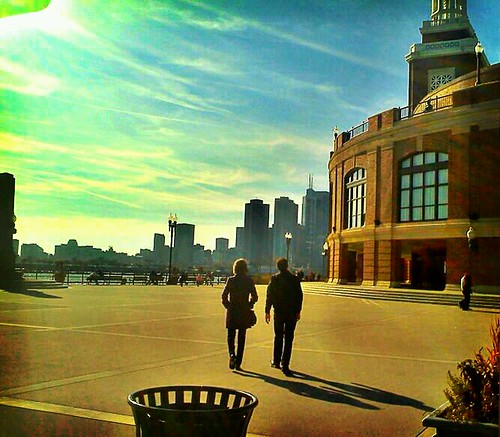Over the weekend I went to my 3rd SOFA Show (Sculptural Objects and Functional Art) and Intuit Show of Folk and Outsider Art at Navy Pier in Chicago. No photographs are allowed and although I saw plenty of people taking pictures, I purchased a moleskin sketchbook for the occasion to log the names of the artists and sketch a piece or two. I also purchased to catalog to remember all of the wonderful pieces.
This year I made up my mind beforehand that I was not going to see the entire show, and was going to stay away from the glass galleries. The last several years SOFA has been over-run with glass work and while I appreciate the individual pieces very much, my opinion is that the show is very weighted towards glass.
The very first thing I did is walk to the back of the room to the Intuit show. I have to admit that the first couple years I saw the show I didn't understand why a drawing that looked like a 5 year old had made with marker on a piece of cardboard would be worth $80,000. Ok, I still might not understand the price tag. I am coming closer to really appreciating the art though.
It is as if these people, who had no formal training in art, and therefore had no words to articulate regarding their art, were driven by an inner passion to create with whatever materials they were able to amass. They created art because it is what their heart told them to do.
This year I made up my mind beforehand that I was not going to see the entire show, and was going to stay away from the glass galleries. The last several years SOFA has been over-run with glass work and while I appreciate the individual pieces very much, my opinion is that the show is very weighted towards glass.
The very first thing I did is walk to the back of the room to the Intuit show. I have to admit that the first couple years I saw the show I didn't understand why a drawing that looked like a 5 year old had made with marker on a piece of cardboard would be worth $80,000. Ok, I still might not understand the price tag. I am coming closer to really appreciating the art though.
It is as if these people, who had no formal training in art, and therefore had no words to articulate regarding their art, were driven by an inner passion to create with whatever materials they were able to amass. They created art because it is what their heart told them to do.
 |
| Howard Finster: Hope |
 |
| Rev. Howard Finster |
Some of them had messages the artist wanted to project. One example is Howard Finster. He was a fiery Baptist minister and artist whose impassioned, and at times nonsensical, ramblings were written over top his pictorial paintings creating a dizzying cacophony of religious zealousness. He was inspired by God to share the gospel with people through paintings of his visions. His visions began at age 3, he stopped school at 6th grade, and was born again during a tent revival at age 13.
 |
| Henry Darger: Vivian Girls Out Scouting |
 |
| Mr. Henery Darger |
Some artwork consisted of the private stories of fancy that needed to be brought into the real world. Henry Darger was this type of artist. During his lifetime, no one knew he had created his world in drawings. In this safe space he controlled the story line of children and battles, danger and happiness. It wasn't until he died and the landlord came to clean out the apartment that Darger's inner world came to light for the rest of us.
 |
| Bill Traylor Blue Man with B in His Back circa 1939-42 |
 |
| Mr. Bill Traylor |
Bill Traylor was born into slavery in Alabama. After emancipation, his family continued to farm the same plantation. When he was 85 he was homeless and lived on the streets and sometimes slept in the back of a funeral parlor. During the day he sat on the sidewalk and drew images of the people he saw on the street and remembered scenes from life on the farm, hanging his works on the fence behind him. A painter friend would give him art supplies. He died at the age of 95.
He is known for is flat, modernistic use of color, his mystery scenes that he calls "exciting events." and the portrayal of unusual, non-identifiable objects he called "constructions."
Sadly, his fame and high regard as an artist came 20 years after his death. The person who had given him art supplies had also kept much of the work. He showed it to art dealers and galleries in the late 70's and it was a hit. He lived his life in extreme poverty. Now a single drawing is priced at $80,000.
Reading the background histories of the artists brought more meaning to their pieces. Understanding the person and their situation and their all encompassing primal need to create is what makes the artwork "art" not doodles.

No comments:
Post a Comment